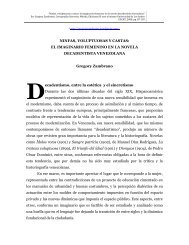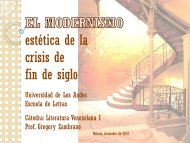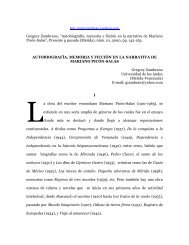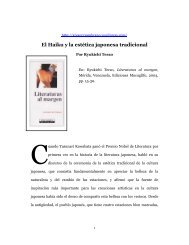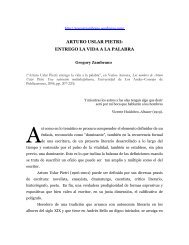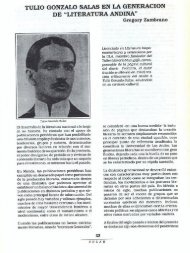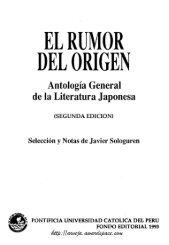- Page 2 and 3:
Blanca
- Page 4 and 5:
Blanca
- Page 6 and 7:
la Universidad de Sofía, nos entre
- Page 8:
de la Universidad de Tokio, en espe
- Page 11 and 12:
CONTENIDO109 Soseki y Cortázar: pr
- Page 13 and 14:
Revista de la Dirección General de
- Page 15 and 16:
“Lo erótico” y la imagen de la
- Page 17 and 18:
“Lo erótico” y la imagen de la
- Page 19 and 20:
“Lo erótico” y la imagen de la
- Page 21 and 22:
“Lo erótico” y la imagen de la
- Page 23 and 24:
“Lo erótico” y la imagen de la
- Page 25 and 26:
“Lo erótico” y la imagen de la
- Page 27 and 28:
Revista de la Dirección General de
- Page 29 and 30:
Fundamentos del jardín japonés...
- Page 31 and 32:
Fundamentos del jardín japonés...
- Page 33 and 34:
Fundamentos del jardín japonés...
- Page 35 and 36:
Fundamentos del jardín japonés...
- Page 37 and 38:
Fundamentos del jardín japonés...
- Page 39 and 40:
Fundamentos del jardín japonés...
- Page 41 and 42:
Fundamentos del jardín japonés...
- Page 43 and 44:
Fundamentos del jardín japonés...
- Page 45 and 46:
Fundamentos del jardín japonés...
- Page 47 and 48:
Fundamentos del jardín japonés...
- Page 49 and 50:
Revista de la Dirección General de
- Page 51 and 52:
Rastros de historia japonesa en la
- Page 53 and 54:
Rastros de historia japonesa en la
- Page 55 and 56: Rastros de historia japonesa en la
- Page 57 and 58: Rastros de historia japonesa en la
- Page 59 and 60: Rastros de historia japonesa en la
- Page 61 and 62: Revista de la Dirección General de
- Page 63 and 64: La literatura clásica japonesa...E
- Page 65 and 66: La literatura clásica japonesa...p
- Page 67 and 68: La literatura clásica japonesa...L
- Page 69 and 70: La literatura clásica japonesa...d
- Page 71 and 72: La literatura clásica japonesa...O
- Page 73 and 74: La literatura clásica japonesa...a
- Page 75 and 76: La literatura clásica japonesa...a
- Page 77 and 78: Revista de la Dirección General de
- Page 79 and 80: Paseo en siete estaciones por la li
- Page 81 and 82: Paseo en siete estaciones por la li
- Page 83 and 84: Paseo en siete estaciones por la li
- Page 85 and 86: Paseo en siete estaciones por la li
- Page 87 and 88: Paseo en siete estaciones por la li
- Page 89 and 90: Paseo en siete estaciones por la li
- Page 91 and 92: Paseo en siete estaciones por la li
- Page 93 and 94: Revista de la Dirección General de
- Page 95 and 96: Huellas de la vida del novelista y
- Page 97 and 98: Huellas de la vida del novelista y
- Page 99 and 100: Huellas de la vida del novelista y
- Page 101 and 102: Huellas de la vida del novelista y
- Page 103 and 104: Huellas de la vida del novelista y
- Page 105: Huellas de la vida del novelista y
- Page 109 and 110: Revista de la Dirección General de
- Page 111 and 112: Soseki y Cortázar: profesores de l
- Page 113 and 114: Soseki y Cortázar: profesores de l
- Page 115 and 116: Soseki y Cortázar: profesores de l
- Page 117 and 118: Soseki y Cortázar: profesores de l
- Page 119 and 120: Soseki y Cortázar: profesores de l
- Page 121 and 122: Retrato de John Keats
- Page 123 and 124: Soseki y Cortázar: profesores de l
- Page 125 and 126: Revista de la Dirección General de
- Page 127 and 128: POEMAS DE / Kazuko ShiraishiJugador
- Page 129 and 130: POEMAS DE:Yutaka HosonoDioses en re
- Page 131 and 132: POEMAS DE / Yutaka HosonoEl rencorE
- Page 133 and 134: Revista de la Dirección General de
- Page 135 and 136: El Mago...Sin embargo, la esposa, e
- Page 137 and 138: El Mago...—“Ahora suelta la man
- Page 139 and 140: Huesos de dios...Prefiero sincerame
- Page 141 and 142: “NO CONFIESES”Yukio MishimaTrad
- Page 143 and 144: No confieses...que no fue en Manchu
- Page 145 and 146: “BOKKO-CHAN”Shinichi HoshiTradu
- Page 147 and 148: Bokko-chan...Cuando no podía conte
- Page 149 and 150: Revista de la Dirección General de
- Page 151 and 152: Entre nuevas imágenes y viejas per
- Page 153 and 154: Entre nuevas imágenes y viejas per
- Page 155 and 156: Entre nuevas imágenes y viejas per
- Page 157 and 158:
Entre nuevas imágenes y viejas per
- Page 159 and 160:
Entre nuevas imágenes y viejas per
- Page 161 and 162:
Entre nuevas imágenes y viejas per
- Page 163 and 164:
Entre nuevas imágenes y viejas per
- Page 165 and 166:
Revista de la Dirección General de
- Page 167 and 168:
Energía renovable y participación
- Page 169 and 170:
Energía renovable y participación
- Page 171 and 172:
Energía renovable y participación
- Page 173 and 174:
Energía renovable y participación
- Page 175 and 176:
Energía renovable y participación
- Page 177 and 178:
Energía renovable y participación
- Page 179 and 180:
Revista de la Dirección General de
- Page 181 and 182:
Semanas Culturales...el intercambio
- Page 183 and 184:
Semanas Culturales...En la ciudad d
- Page 185 and 186:
Semanas Culturales...oficial a Jap
- Page 187 and 188:
Semanas Culturales...ambas partes.
- Page 189 and 190:
Semanas Culturales...BIBLIOGRAFÍA
- Page 191 and 192:
Revista de la Dirección General de
- Page 193 and 194:
Takako Kodani, de la Serie “Mirad
- Page 195 and 196:
Revista de la Dirección General de
- Page 197 and 198:
Junichiro Tanizaki: del mundo flota
- Page 199 and 200:
Junichiro Tanizaki: del mundo flota
- Page 201 and 202:
Junichiro Tanizaki: del mundo flota
- Page 203 and 204:
Revista de la Dirección General de
- Page 205 and 206:
LOS AUTORESespecializados sobre tem
- Page 207 and 208:
LOS AUTORESYukio Mishima (1925- 197
- Page 209 and 210:
LOS AUTORESCarlos Fuentes, Mario Va
- Page 211 and 212:
CANJE / INTERNACIONAL21 Inter.-Amer
- Page 213 and 214:
CANJE / INTERNACIONAL64 The Univers
- Page 215 and 216:
CANJE / NACIONAL31 Revista Scientia



